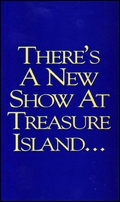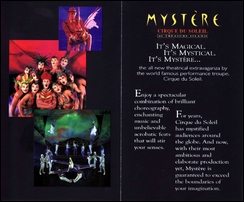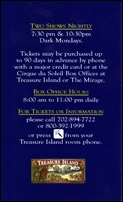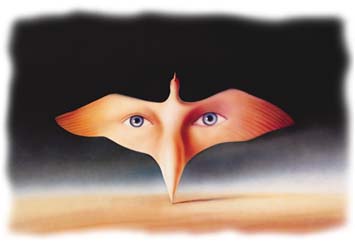

![]()
1980s
1982 · 19831984 · 1985
1986 · 1987
1988 · 1989
1990s
1990 · 19911992 · 1993
1994 · 1995
1996 · 1997
1998 · 1999
2000s
2000 · 20012002 · 2003
2004 · 2005
2006 · 2007
2008 · 2009
2010s
2010 · 20112012 · 2013
2014 · 2015
2016 · 2017
2018 · 2019
2020s
2020 · 20212022 · 2023
2024

A BAROQUE ODYSSEY (10 YEARS) The sun never sets on the Cirque du Soleil. That's the 10th anniversary motto, said Gilles Ste-Croix, artistic director of Montreal's vagabond sunshine circus, but perhaps only partly in jest. Over the last ten years, the Cirque team has developed into a solid core of creative talent. In addition to Gilles Ste-Croix and founder-creator Guy Lalibertê, the team includes director Franco Dragone, costumer Dominique Lemieux, scenic designer Michel Crête, composer René Dupéré, choreographer Debra Brown and lighting designer Luc Lafortune.
Their efforts combine to produce a special style, in which the age-old elements of circuses are mixed with the technical innovations and new age design that makes Cirque so remarkable. "Through the last few years," Ste-Croix says, "we have been able to build up a good team. We function well. We understand each other. We know where we want to go. Our work is continuing, constant; it grows and develops. It's like a painter. You have to look at all of his pictures to see the complete range of his work, but they all clearly come from the same artist." Then, shifting to another metaphor, he adds, "We are like good chefs in a kitchen. We know that our recipe works. But what we present to our customers is in no way a warming up of the sauce."
The team comes together to celebrate Cirque du Soleil's 10th anniversary by staging Alegría -- joy in Spanish -- the phrase that shapes the production is: The fools have lost their king. "People seem to be very morose today," says Ste-Croix, explaining the origins of the title. "Everybody now has a global concern, but they're also living in a world of uncertainty and complaining a lot about this. So we decided to call the new show Alegria, which can also be translated as a scream of joy." He adds, "Alegria is like a scream of joy, a scream of life against the moroseness. We would say, 'The king is dead. Alegria!' Because there is life after death in the sense that something new is coming." In this $3-million production, something old is evoked in Cirque-speak, a visual language that may not be immediately decipherable. The old regime, for example, is represented by feathers and performers in bird costumes, inspired by the "gilded year" at the turn of the century ruled by railroad and petroleum barons. As for the new world, simply look down. "Alegria" has more performers under 18 than any other Cirque production. "When you have a child of 12 who does incredible feats and comes straight at you on the stage and looks at you in the eyes with a smile and goes, 'Hey!'" Ste-Croix says, "you are really taken by that power because they are there to be the future, whereas the old birds represent the period that we are living through that is dying."
True to tradition, the two-year North American tour is launched in Montreal. Meanwhile, Mystère continues to create a sensation in Las Vegas (683,294 people see the show) and Saltimbanco embarks on a six-month run in Tokyo that attracts a great deal of attention (and spectators; 557,851 see Saltimbanco in Tokyo). 
 |


![[Back]](../images/arrow.gif)













